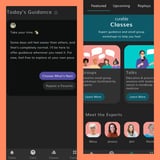I don’t recall the exact date when I realized my chronic, widespread pain wasn’t normal. But the summer of 2019 stands out. I woke up one morning after a solo drive from Seattle to Orange County and the carpet under my tingly feet felt like a bed of nails. I knew I had to search for answers as years of other unexplained symptoms flooded my mind. A dull ache in my lower back had started many years earlier. I mostly ignored it. Then, in my late thirties, nerve pain in my hands and wrists spurred a yearlong process that included physical therapy, X-rays, and an MRI with no conclusive results. Setting up an ergonomic workstation alleviated my symptoms enough to make work manageable. The subsequent increase in pain was gradual until my mid-forties. By then I lived with daily neck, shoulder, and worsening back pain. I lay in bed at night marveling at my extremities buzzing with electricity. I knew my lifelong anxiety must be related because the more heightened my “fight or flight” response, the worse the pain, but I didn’t understand why. I told doctors and physical therapists, “Everything is connected,” and I cried in my new rheumatologist’s office when bloodwork to rule out autoimmune diseases and a nerve conduction test revealed nothing.
In 2021, I was finally diagnosed with fibromyalgia. According to the Mayo Clinic, the disorder is characterized by “widespread musculoskeletal pain accompanied by fatigue, sleep, memory and mood issues.” The condition is suspected to amplify painful sensations “by affecting the way your brain and spinal cord process painful and nonpainful signals,” per the Mayo Clinic. A single event can trigger the ailment, or, like in my case, symptoms can accumulate over time. I also have other diagnoses that tend to coexist alongside fibromyalgia, including interstitial cystitis and IBS, both of which I’ve had since my late twenties. But having a diagnosis of fibromyalgia initially lifted my spirits. I thought it would explain the symptoms my other conditions couldn’t, and I was told I had options.
To manage the daily pain, frequent brain fog, and sporadic days of full-body exhaustion, my primary care doctor suggested a combination of nerve pain medication, anti-inflammatory drugs, and antidepressants. But nothing worked. “You have complicated brain chemistry,” my psychiatrist told me.
After conferring with friends and reading online articles, I endured two nauseating acupuncture sessions and three panic-inducing trips to a ketamine clinic. Then, I saw a segment on tv about a man who cured debilitating back pain with pain reprocessing therapy. PRT involves retraining the brain so it no longer misinterprets the signals sent to the body that scream, “You’re in danger!” when you’re not. PRT is based on the concept that nonstructural pain is neuroplastic and therefore reversible. The process involves psychological strategies that remove fear and “turn off” the signals that cause pain, including understanding what’s happening in the brain and how pain can be reversed; amassing personal data to support that reversal; and moving toward more positive mental and physical emotions that relieve stress.
In researching this method, I stumbled on the Curable app, which offers self-directed treatment that walks users through PRT with four types of prerecorded activities: education, meditation, writing, and brain training. At this point, I was desperate for relief and put the app to the test for seven months. To my surprise, it has begun to change everything.
My Experience With Curable
When I opened the Curable app for the first time, I encountered an inviting cartoon AI lady named Clara at the top of the screen next to a button that read “Choose what’s next.” Her encouraging written dialogue said I’d create a personal “Roadmap” on the home page that would grow lengthier each time I tried something new, an ideal layout for a perfectionist who bases her worth on her accomplishments. I was excited to tackle the process of transforming my neural pathways, no matter how long it took. I started with “education,” taking a tour of the app and all its exercises, including “basic neuroscience of pain,” “how to: brain training,” a “pep talk,” and “how pain becomes chronic.” After each exercise, Clara would ask if it was helpful, then handpick new activities for me based on what I liked most. I could “star” my favorites and return to them any time from the home page.
Image Source: Chelsey Drysdale/Curable
After burning through the educational recordings, I dove into a “releasing fear” meditation to calm down my amygdala. Each guided meditation has three options: ten-, fifteen-, and twenty-minute versions. Some favorites include a “surrender meditation,” during which I visualized floating in water; a “boundary setting meditation” as a reminder to protect my energy; a “progressive relaxation” meditation in which I settled onto my yoga mat and tightened and relaxed my muscles; and a “decision-making meditation” to get unstuck when I’m in analysis paralysis mode.
The road to recovery is not a straight line, but through each of the more than eighty exercises I’ve completed so far – some multiple times – I have hope.
After meditating several times for a couple weeks, I clicked on the “graded motor imagery” exercise. In a recording, a physical therapist explained a writing technique involving listing activities I avoid because of pain and activities I’d like to add back into my life. I was then directed to choose online images of others performing these same activities pain-free and visualize myself in similar circumstances, then write about how I felt. I focused on air travel but could have chosen something as simple as cleaning the bathroom. I thought about how my world had gotten smaller and more limited as my pain has progressed. Looking at photos of smiling, joyful faces of people traveling reminded me I used to be one of them and would really like to feel that carefree again. I simultaneously felt sorrowful yet determined to become more like my old self. The goal, the app said, is to break experiences into more manageable parts – in my case, taking a short domestic flight instead of suffering through one overseas, which I’ve since done with less fear and discomfort than usual.
Image Source: Chelsey Drysdale/Curable
In the past seven months, the technique I find most useful, though, is “somatic tracking,” a core element of PRT that teaches the brain how to switch off “false alarms.” I close my eyes and listen to the calm voice of Alan Gordon, LCSW, who completed a PRT neuroimaging study in conjunction with the University of Colorado-Boulder. In a seven-and-a-half minute recording, I was encouraged to observe an uncomfortable sensation – like tightness in my neck – with curiosity and remind myself the sensation is “safe.” The more I investigate pulsating pangs without attaching to an outcome, the more positive neural pathways I create, Gordon says. While I’m not totally pain-free yet, the exercise works in the moment.
With Curable’s direction, I’ve scribbled down stressors and how I feel about them: panic about the physical effects of long-term anxiety; despair about aging; hopelessness about my current lack of financial stability; assumptions that I’m unaccomplished because my memoir still isn’t published; worry that my pain will never go away; and sadness that I may stay single forever. After dumping negative thoughts onto the page, the app suggests I show myself compassion. How would I treat my closest friend or my innocent childhood self? What does the rational part of my brain think about all the fairy tales my mind mistakenly tells me? I can honor these feelings but also recognize they no longer serve me. The app provides a reality check and a reset for my motivation and confidence, and surprisingly, it really does relieve the tension that causes my pain. These exercises have made me feel lighter and more optimistic, not unlike how I felt each time I left my therapist’s office for four years. While the app isn’t a replacement for talk therapy, it’s a satisfying supplement after completing traditional methods.
The road to recovery is not a straight line, but through each of the more than eighty exercises I’ve completed so far – some multiple times – I have hope.
What I Like About Curable
In addition to a roadmap filled with starred exercises to return to as part of my weekly wellness plan – alongside stretching, walking, cardio, and mild yoga – the Curable app includes a panic mode for coached breathing through a panic attack (something I’ve struggled with on and off since high school). The app also offers many interviews and uplifting recovery stories that I can listen to in my car, in addition to a podcast, “Like Mind, Like Body.” A Curable Community exists on Facebook, too, and currently boasts nearly 25,000 members. I have yet to share my story or ask any questions there, but I’m impressed with the open, welcoming nature of others’ posts. Curable makes me feel less alone. With its user-friendly interface and concise exercises, I can build it into my freelance schedule, much like an asynchronous class.
Image Source: Chelsey Drysdale/Curable
What’s Worth Noting About Curable
This month Curable released a substantial update, including more personalized daily guidance. A “Today” tab showcases a suggested exercise tailored to my symptoms. There’s a new full-app search function. I can also organize my favorite content in “Collections.” Live talks and replays of mind-body video presentations with Q&As, plus small-group workshops, are located in the “Curable Classes” section.
That said, as much as I like Curable, no app can cure chronic illness. I still often awaken with lower back pain. I still get headaches. My neck still feels like it’s clamped in a vice sometimes. But I am learning to forgive myself for genetic propensities that are ultimately repairable. My rheumatologist did all she could do; now the power is mine to harness.
Who Is Curable Good For?
In addition to people with fibromyalgia, Curable may be good for anyone who experiences pain. But users are encouraged to consult their doctors before starting the Curable journey. The suggested path is one lesson per day three days per week, but there’s no set time frame for alleviating symptoms. Curable suggests recovery could take weeks or months. And every body is different.
Additional Details
- Several MDs and PhDs make up the scientific advisory board behind the app.
- There’s a “try the app” function on the website to check it out prior to purchase.
- Pricing is currently $8 per month, a promotional price for a one-year subscription that is subsequently billed at full price annually ($16 per month).
- “Curable Classes” are an additional fee of $99 per month. The app provides a thirty-day money-back guarantee.
Chelsey Drysdale is a Southern California-based freelance writer and editor. Her work has appeared in The Washington Post, BuzzFeed, The Coachella Review, Brevity, and more.




